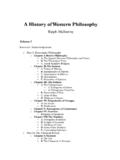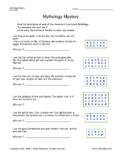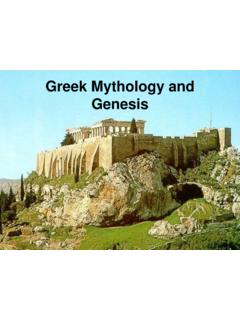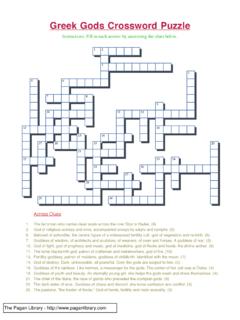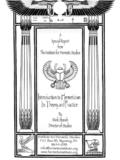Transcription of Robert Graves – The Greek Myths - 24grammata
1 Robert Graves The Greek Myths 1955, revised 1960 Robert Graves was born in 1895 at Wimbledon, son of Alfred Perceval Graves , the Irish writer, and Amalia von Ranke. He went from school to the First World War, where he became a captain in the Royal Welch Fusiliers. His principal calling is poetry, and his Selected Poems have been published in the Penguin Poets. Apart from a year as Professor of English Literature at Cairo University in 1926 he has since earned his living by writing, mostly historical novels which include: I, Claudius; Claudius the God; Sergeant Lamb of the Ninth; Count Belisarius; Wife to Mr Milton (all published as Penguins); Proceed, Sergeant Lamb; The Golden Fleece; They Hanged My Saintly Billy; and The Isles of Unwisdom. He wrote his autobiography, Goodbye to All That (a Penguin Modem Classic), in 1929.
2 His two most discussed non-fiction books are The White Goddess, which presents a new view of the poetic impulse, and The Nazarene Gospel Restored (with Joshua Podro), a re-examination of primitive Christianity. He has translated Apuleius, Lucan, and Svetonius for the Penguin Classics. He was elected Professor of Poetry at Oxford in 1962. Contents Foreword Introduction I. The Pelasgian Creation Myth 2. The Homeric And Orphic Creation Myths 3. The Olympian Creation Myth 4. Two Philosophical Creation Myths 5. The Five Ages Of Man 6. The Castration Of Uranus 7. The Dethronement Of Cronus 8. The Birth Of Athene 9. Zeus And Metis 10. The Fates 11. The Birth Of Aphrodite 12. Hera And Her Children 13. Zeus And Hera 14. Births Of Hermes, Apollo, Artemis, And Dionysus 15. The Birth Of Eros 16. Poseidon s Nature And Deeds 17. Hermes s Nature And Deeds 18.
3 Aphrodite s Nature And Deeds 19. Ares s Nature And Deeds 20. Hestia s Nature And Deeds 21. Apollo s Nature And Deeds 22. Artemis s Nature And Deeds 23. Hephaestus s Nature And Deeds 24. Demeter s Nature And Deeds 25. Athene s Nature And Deeds 26. Pan s Nature And Deeds 27. Dionysus s Nature And Deeds 28. Orpheus 29. Ganymedes 30. Zagreus 31. The Gods Of The Underworld 32. Tyche And Nemesis 33. The Children Of The Sea 34. The Children Of Echidne 35. The Giants Revolt 36. Typhon 37. The Aloids 38. Deucalion s Flood 39. Atlas And Prometheus 40. Eos 41. Orion 42. Helius 43. The Sons Of Hellen 44. Ion 45. Alcyone And Ceyx 46. Tereus 47. Erechtheus And Eumolpus 48. Boreas 49. Alope 50. Asclepius 51. The Oracles 52. The Alphabet 53. The Dactyls 54. The Telchines 55. The Empusae 56. Io 57. Phoroneus 58. Europe And Cadmus 59. Cadmus And Harmonia 60. Belus And The Danaids 61.
4 Lamia 62. Leda 63. Ixion 64. Endymion 65. Pygmalion And Galatea 66. Aeacus 67. Sisyphus 68. Salmoneus And Tyro 69. Alcestis 70. Athamas 71. The Mares of Glaucus 72. Melampus 73. Perseus 74. The Rival Twins 75. Bellerophon 76. Antiope 77. Niobe 78. Caenis And Caeneus 79. Erigone 80. The Calydonian Boar 81. Telamon And Peleus 82. Aristaeus 83. Midas 84. Cleobis And Biton 85. Narcissus 86. Phyllis And Carya 87. Arion 88. Minos And His Brothers 89. The Loves Of Minos 90. The Children Of Pasipha 91. Scylla And Nisus 92. Daedalus And Talos 93. Catreus And Althaemenes 94. The Sons Of Pandion 95. The Birth Of Theseus 96. The Labours Of Theseus 97. Theseus And Medea 98. Theseus In Crete 99. The Federalization Of Attica 100. Theseus And The Amazons 101. Phaedra And Hippolytus 102. Lapiths And Centaurs 103. Theseus In Tartarus 104. The Death Of Theseus 105.
5 Oedipus 106. The Seven Against Thebes 107. The Epigoni 108. Tantalus 109. Pelops And Oenomaus 110. The Children Of Pelops 111. Atreus And Thyestes 112. Agamemnon And Clytaemnestra 113. The Vengeance Of Orestes 114. The Trial Of Orestes 115. The Pacification Of The Erinnyes 116. Iphigeneia Among The Taurians 117. The Reign Of Orestes 118. The Birth Of Heracles 119. The Youth Of Heracles 120. The Daughters Of Thespius 121. Erginus 122. The Madness Of Heracles 123. The First Labour: The Nemean Lion 124. The Second Labour: The Lernaean Hydra 125. The Third Labour: The Ceryneian Hind 126. The Fourth Labour: The Eryminthian Boar 127. The Fifth Labour: The Stables Of Augeias 128. The Sixth Labour: The Stymphalian Birds 129. The Seventh Labour: The Cretan Bull 130. The Eighth Labour: The Mares Of Diomedes 131. The Ninth Labour: Hippolyte s Girdle 132. The Tenth Labour: The Cattle Of Geryon 133.
6 The Eleventh Labour: The Apples Of The Hesperides 134. The Twelfth Labour: The Capture Of Cerberus 135. The Murder Of Iphitus 136. Omphale 137. Hesione 138. The Conquest Of Elis 139. The Capture Of Pylus 140. The Sons Of Hippoco n 141. Auge 142. Deianeira 143, Heracles In Trachis 144. Iole 145. The Apotheosis Of Heracles 146. The Children Of Heracles 147. Linus 148. The Argonauts Assemble 149. The Lemnian Women And King Cyzicus 150. Hylas, Amycus, And Phineus 151. From The Symplegades To Colchis 152. The Seizure Of The Fleece 153. The Murder Of Apsyrtus 154. The Argo Returns To Greece 155. The Death Of Pelias 156. Medea At Ephyra 157. Medea In Exile 158. The Foundation Of Troy 159. Paris And Helen 160. The First Gathering At Aulis 161. The Second Gathering At Aulis 162. Nine Years Of War 163. The Wrath Of Achilles 164. The Death Of Achilles 165.
7 The Madness Of Ajax 166. The Oracles Of Troy 167. The Wooden Horse 168. The Sack Of Troy 169. The Returns 170. Odysseus s Wanderings 171. Odysseus s Homecoming FOREWORD SINCE revising The Greek Myths in 1958, I have had second thoughts about the drunken god Dionysus, about the Centaurs with their contradictory reputation for wisdom and misdemeanour, and about the nature of divine ambrosia and nectar. These subjects are closely related, because the Centaurs worshipped Dionysus, whose wild autumnal feast was called the Ambrosia . I no longer believe that when his Maenads ran raging around the countryside, tearing animals or children in pieces and boasted afterwards of travelling to India and back, they had intoxicated themselves solely on wine or ivy ale. The evidence, summarized in my What Food the Centaurs Ate (1958), suggests that Satyrs (goat-totem tribesmen), Centaurs (horse-totem tribesmen), and their Maenad womenfolk, used these brews to wash down mouthfuls of a far stronger drug: namely a raw mushroom, amanita muscaria, which induces hallucinations, senseless rioting, prophetic sight, erotic energy, and remarkable muscular strength.
8 Some hours of this ecstasy are followed by complete inertia; a phenomenon that would account for the story of how Lycurgus, armed only with an ox-goad, routed Dionysus s drunken army of Maenads and Satyrs after its victorious return from India. On an Etruscan mirror the amanita muscaria is engraved at Ixion s feet; he was a Thessalian hero who feasted on ambrosia among the gods. Several Myths are consistent with my theory that his descendants, the Centaurs, ate this mushroom; and, according to some historians, it was later employed by the Norse berserks to give them reckless power in battle. I now believe that ambrosia and nectar were intoxicant mushrooms: certainly the amanita muscaria; but perhaps others, too, especially a small, slender dung-mushroom named panaeolus papilionaceus, which induces harmless and most enjoyable hallucinations.
9 A mushroom not unlike it appears on an Attic vase between the hooves of Nessus the Centaur. The gods for whom, in the Myths , ambrosia and nectar were reserved, will have been sacred queens and kings of the pre-Classical era. King Tantalus s crime was that he broke the taboo by inviting commoners to share his ambrosia. Sacred queenships and kingships lapsed in Greece; ambrosia then became, it seems, the secret element of the Eleusinian, Orphic and other Mysteries associated with Dionysus. At all events, the participants swore to keep silence about what they ate or drank, saw unforgettable visions, and were promised immortality. The ambrosia awarded to winners of the Olympic footrace when victory no longer conferred the sacred kingship on them was clearly a substitute: a mixture of foods the initial letters of which, as I show in What Food the Centaurs Ate, spelled out the Greek word mushroom.
10 Recipes quoted by Classical authors for nectar, and for cecyon, the mint-flavoured drink taken by Demeter at Eleusis, likewise spell out mushroom . I have myself eaten the hallucinogenic mushroom, psilocybe, a divine ambrosia in immemorial use among the Masatec Indians of Oaxaca Province, Mexico; heard the priestess invoke Tlaloc, the Mushroom-god, and seen transcendental visions. Thus I wholeheartedly agree with R. Gordon Wasson, the American discoverer of this ancient rite, that European ideas of heaven and hell may well have derived from similar mysteries. Tlaloc was engendered by lightning; so was Dionysus; and in Greek folklore, as in Masatec, so are all mushrooms proverbially called food of the gods in both languages. Tlaloc wore a serpent-crown; so did Dionysus.

